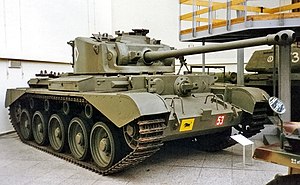Comet (tank)
| Tank, Cruiser, Comet I (A34) | |
|---|---|
 Comet tank in a museum | |
| Type | Cruiser tank |
| Place of origin | |
| Service history | |
| In service | December 1944 - 1958 (UK) |
| Used by | British Army |
| Wars | World War II Korean War |
| Production history | |
| Designed | 1943 |
| Manufacturer | Leyland Motors Ltd |
| Produced | September 1944 |
| No. built | 1,186[1] |
| Specifications | |
| Mass | 33 long tons (33 tonnes) |
| Length | 21 ft 6 in (6.55 m) |
| Width | 10 ft 1 in (3.04 m) |
| Height | 8 ft 6 in (2.67 m) |
| Crew | 5 (Commander, gunner, loader, driver, co-driver) |
| Armour | 4 in (102 mm) |
Main armament | 77 mm HV 61 rounds |
Secondary armament | 2 x 7.92 mm Besa MG |
| Engine | Rolls-Royce Meteor V12 petrol 600 hp (447 kW) |
| Power/weight | 17 hp/ton (18 hp/tonne) |
| Suspension | Christie |
| Ground clearance | 18 in (0.5 m) |
| Fuel capacity | about 120 Imperial gallons |
Operational range | 250 km |
| Maximum speed | 32 mph (50 km/h) |
The Tank, Cruiser, Comet I (A34) was a British tank that first saw use near the end of World War II.
Production
Combat experience against the Germans in the Western Desert Campaign demonstrated to the British the inferiority of their tanks. A request was thus made to Leyland Motors Ltd for a new tank that could achieve combat superiority over German models; for reasons of economy and efficiency, it additionally had to use as many components of their Cromwell tank as possible.
The initial design was the Challenger. In order to mount the 17 pounder anti-tank gun a very large turret was required and the Cromwell hull had to be completely redesigned in order to accommodate it, being both lengthened and widened. Unfortunately, the Challenger proved to be a major disappointment in service and ultimately production was stopped after only 200 units were built.
In a second attempt (the A34), the tank designers opted to use a highly-modified version of the 17 pounder, the 77 mm. The new gun was still of the same 76.2 mm calibre as the 17 pdr, but was designated "77mm" because it used ammunition that was different and non-interchangeable with the 17 pdr, and also had a lower muzzle velocity than the original gun. Several other upgrades were added as well: armour protection was increased, both the hull and turret were of welded construction with a cast mantlet, ammunition was now stored in armoured bins, the suspension was strengthened, return rollers were added, and the turret was electrically traversed (a design feature taken from the earlier Churchill tank), with a generator powered by the main engines.
The first prototype was ready in February 1944 and production models began to be delivered in September. By the end of the war, 1,200 units had been produced.
Usage
The British 11th Armoured Division was the first to receive the new tanks in December of 1944 and the only division to be completely refitted by the end of the war. Because of its late arrival, the Comet did not participate in any major battles though it was involved in the crossing of the Rhine and the later Berlin Victory Parade in July 1945. The Comet tank's maximum speed of 32 miles per hour was greatly exploited on the German Autobahns.
During the following Korean War, the Comet served along with the heavier Centurion, a successor tank introduced in 1949 partially based on its design. The Comet remained in British service until 1958 when the remaining tanks were sold to foreign governments; up until the 1980s, it could be found in the armies of various nations such as South Africa.
41 Comet Mk I Model Bs were also used by Finnish Defence Forces armoured brigade until 1970. The tanks were stored until 2007 when they were auctioned out.
8 Comets were delivered to the Irish Army, beginning in 1959. Severe budget cutbacks were to severly harm the service lives of the Comets, as not enough spares were purchased. The Comet appealed to the Army as it was cheap to buy and run, had low ground pressure, and good anti-tank capability. In retrospect it was an excellent buy, and would have stood the Army in good stead had vital spares been supplied initially. However, faulty fuzes meant the withdrawal of the HE ammunition, limiting the tanks role to an anti-tank vehicle. With stocks of 77mm ammunition dwindling in 1969, the Army began an experiment to prolong the life of the vehicle. It involved replacing the turret with an open mounting with a 90mm Bofors PV 1110 recoiless rifle. Lack of funds saw a cancellation of the project. The last 77mm Comet shoot occurred in 1973 and the tanks were withdrawn soon afterwards. One is preserved in the Curragh Camp, and two more survive in other Barracks.
Operators
References
- The Illustrated Directory of Tanks of the World: From World War I to the Present Day
- Tanks of World War II
- WWII Vehicles
